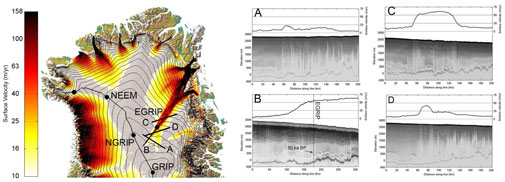
The behavior of the fast flowing ice streams within the Greenland ice sheet is not well understood. The ice streams discharge icebergs into the ocean that accounts for half the loss of mass from the Greenland ice sheet and many ice streams have doubled their velocities during the last decade.
There is a need to understand the processes of the ice streams before they properly can be included in ice-sheet models, which will enable predictions of future loss of mass via ice streams and thus improve the fidelity of the estimates of future sea-level rise.

The map shows Greenland and the Northeast Greenland Ice Stream (NEGIS).
Velocities from RADARSAT synthetic aperture radar data are shown in color (Joughin et al., Journ. Glac., 2010) and illustrate the wedge of fast-flowing ice that begins right at the central ice divide and cuts through the ice sheet to feed into the ocean through three large ice streams (Nioghalvfjerds isstrømmen, Zachariae isbræ, and Storstrømmen).
Panels A-D show radio-echo sounding profiles recorded from an airplane and surface velocities have been extracted from the map to the left. The radar profile marked B obtained by University of Kansas shows that the ice thickness at the proposed EastGRIP drill site is 2550 m and that undisturbed layers are detected to 50,000 years before present. The surface velocity is 65 m/yr at the proposed drill site, indicated by the EGRIP line, corresponding to that the drill hole will move sideways along with the ice by about one hole diameter every day.
The onset of the ice stream on the ice divide is believed to be caused by strong melting at the base and the ice reaches velocities of more than 100 m/yr just 200 km from the ice divide, but still 500 km from the coast where the ice is heavily crevassed. The EastGRIP drill site has been chosen inside the ice stream far enough away from the margin to be free from crevasses.
We will drill an ice core to bedrock through 2550 m of ice in order to allow us to fulfill the following objectives:
- study the dynamics of the ice flow in an ice stream by ice rheology and deformation studies of the ice core.
- study the dynamics of the ice flow by borehole observations of basal sliding, borehole deformation, and basal water processes.
- Besides from the objectives related to ice dynamics, we expect to obtain a climate records going at least half way through the glacial period. The climatic studies of the core will focus on
- high-resolution climate records of greenhouse gasses, water isotopes and impurities through the last 25,000 years covering the onset of the present interglacial,
- the climatic optimum 8,000 years ago and the industrial period of the past two hundred years.
The EastGRIP camp has an airstrip as well as accommodation and workshop facilities. These facilities attract associated programs, which use the camp as an airport or logistics hub for other projects.
Read more about the scientific objectives and this years’ associated projects in the field plan.
